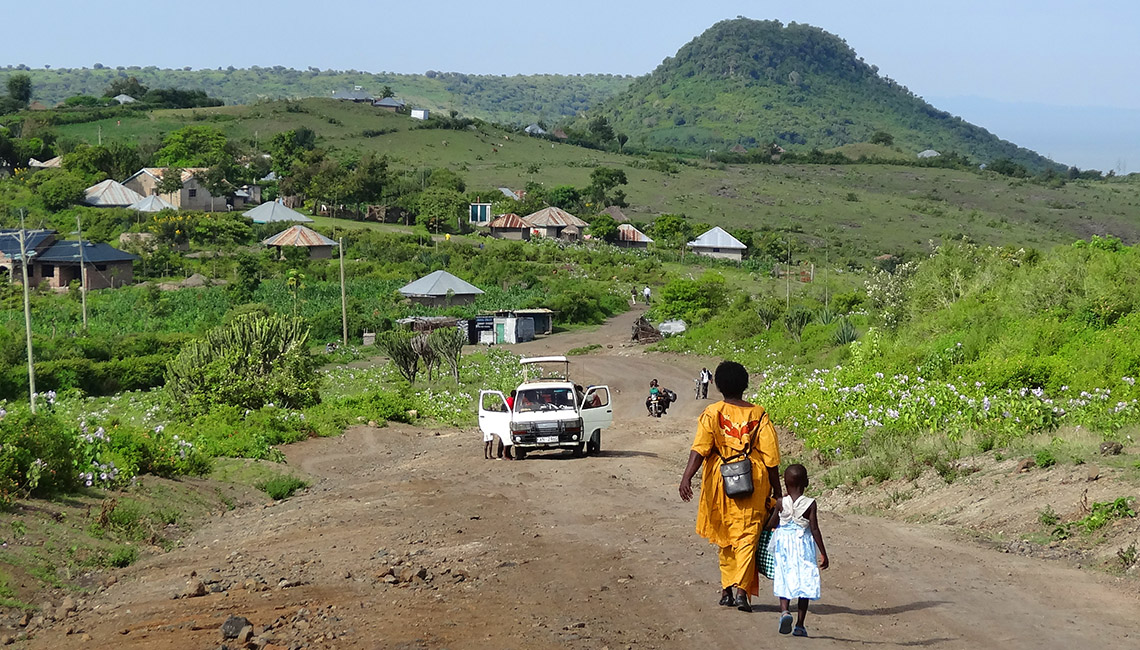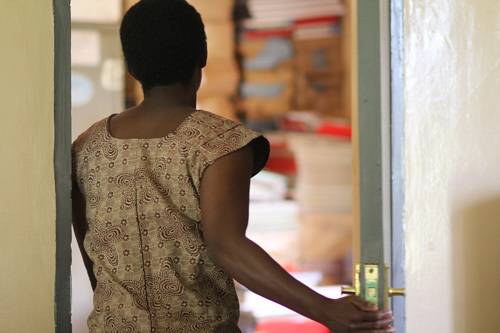PamojaTogether: Telling the Stories of Foreign Aid.

PamojaTogether is a student-powered global news network funded by the Bill and Melinda Gates Foundation that tells the stories of foreign aid from the perspective of the recipient.
Pamoja, the Kiswahili word for together, connects students from countries that receive aid with peers from donor countries in a student-to-student learning process. PamojaTogether is a partnership between Boston University, Jaramogi Oginiga Odinga University of Science and Technology, and Great Lakes University of Kisumu. This global health reporting project sent eight BU students from the BU School of Public Health, BU College of Communication, and BU College of Arts and Sciences to western Kenya where they teamed up with 10 Kenyan students to identify and report on these global health stories.
The goal: to nurture the conversation about aid; tell raw, authentic, and inspiring stories from the field; and engage a worldwide audience in re-imagining aid by telling it like it is.
This is the first of four installments exploring various facets of the way foreign aid is applied on the ground.
Part 1: Direct health initiatives
It’s almost the punchline to an unfunny joke but most Americans have absolutely no idea of how much — actually, how little — the country spends on foreign aid. A 2013 Kaiser Family Foundation survey on the U.S. role in global health found that, when asked to guess how much the country spent on foreign aid, the average answer was 28 percent. The correct answer is just under 1 percent.
When Americans hear or read about foreign aid, it’s often shrouded in the misleading context of what the U.S. and other prosperous countries spend on “general foreign assistance.” That’s a hazy, nebulous catch-all term that lumps all aid into one big basket, a basket that also includes military and strategic programs that link U.S. donations with U.S. national security goals.
But in 2012 the U.S. spent only about $30.5 billion in direct development funding, which Oxfam America defines as aid that is “specifically directed toward improving livelihoods and promoting economic growth; providing much-needed services, such as health care and schooling; and creating lasting solutions to poverty.” Private entities spent about the same amount, with contributions coming from an array of non-governmental organizations (NGOs), foundations, corporations, faith-based groups, and universities and colleges.
A substantial part of foreign aid is dedicated to direct health initiatives designed to have an immediate benefit on people or populations. In some cases, actions to spur better heath today actually perform double duty by encouraging changes that could improve future health for generations. These efforts sit at the critical intersection of personal interaction and policy implementation, the very place where foreign aid can have its greatest positive effect. It is there at street level — in the busy village clinic, or in the shaded waiting room of a rural hospital — where the personal stories of foreign aid are told.
Among the goals of PamojaTogether is to chronicle how direct, first-person observations of foreign aid in action can offer benefits that extend beyond the country that receives the aid. Reporters and videographers explored an array of initiatives that include outreach to at-risk populations such as HIV-positive men, mothers and sex workers; malaria-prevention campaigns targeting mothers and infants; and extending treatment opportunities to children with a potentially fatal, yet curable form of cancer.
HIV Positive Mentor Mothers
A program that employs mothers with HIV to connect with newly diagnosed peers hopes to reduce the spread of HIV in infants, reports Miluka Gunaratna.
Only a few years ago in many parts of Kenya, newly pregnant women who tested HIV positive believed they had received the equivalent of an extended death sentence. This numbing mindset of futility, of the dire inevitability of HIV transmission from mother to newborn child, was also common among many community health workers whose training had not kept pace with advances in antiretroviral therapies.
A 2011 UNICEF survey found that about 900 children were newly infected with HIV each day, with more than 90 percent occurring in sub-Saharan Africa. The survey estimated that only 57 percent of pregnant HIV-positive women were receiving antiretroviral drugs, and fewer still were taking the prescribed course of treatment to prevent maternal-to-child transmission.
Modern interventions with antiretroviral drugs can reduce mother-to-newborn HIV transmission rates to well under 5 percent and improve the health of both mother and child. Miluka Gunaratna, a writer and videographer from SPH, detailed the efforts of a program that hires HIV-positive mothers to become mentors for other women in the same circumstances. “They take mothers from the same community and have them conduct workshops and provide counseling. They become a resource for other mothers to let them know that this is not a death sentence. This does not mean the end of life for your baby. You will be able to deliver a healthy baby if you want.
“It was very empowering, for everyone,” Gunaratna said. “We always talk about sustainability when it comes to foreign aid. You don’t want to be an outside person coming into an area and doing all the work. You want the people on the ground to be able to do things for themselves. I think this is a pretty good example of that.” Full story and video
A Cancer Aimed at Kids
Videographer Jim Dandee of COM and reporter Calvin Ouma of JOOUST examined the role of foreign aid at a local hospital in western Kenya providing life-saving treatment for young cancer patients.
For many African children who survive repeated bouts of malaria or mononucleosis, another potential killer can stalk unnoticed — until too late. Burkitt’s lymphoma is an opportunistic lymphatic cancer that afflicts children in many areas of equatorial Africa where malaria and persistent viral infections have helped compromise victims’ immune systems.
The aggressive, rapidly growing disease accounts for half of all childhood cancer cases in equatorial Africa. If discovered early, chemotherapy can yield survival rates as high as 90 percent. Burkitt’s is rare in the developed world, where early diagnosis and treatment have helped many children survive . One of them was Boston Mayor Marty Walsh, who underwent several rounds of chemotherapy in second and third grades. For many African families, travel to hospitals can be daunting and chemotherapy costs can keep life-saving treatment out of reach. Foreign aid helps fund satellite clinics that reduce travel times, train local health care providers, and help defray medical costs for families.
PamojaTogether reporter Calvin J. Ouma interviewed patients at two facilities close to Lake Victoria who are benefitting from research sponsored by the Kenya Medical Research Institute (KEMRI); the US Centers for Disease Control and Prevention; and the Epidemiology of Burkitt Lymphoma in East-African Children and Minors (EMBLEM) project; and the OGRA Foundation, a Kenyan NGO.
 Malaria and Motherhood
Malaria and Motherhood
Jessica Wiley discovered that research funding has become a financial lifeline for some struggling hospitals overwhelmed by the costs of providing care.
In tropical sub-Saharan Africa, the persistent presence of malaria kills up to 200,000 newborns each year, making maternal malaria treatment a priority for many aid organizations. Pregnant women are particularly susceptible to the disease, which can trigger a host of health concerns that, without intervention, can rapidly escalate to threaten the lives of both the mother and her unborn child.
All pregnant women in Kenya are encouraged to get preventative malaria treatment during prenatal visits. A 2010 survey found that despite 86 percent of Kenyan women getting two or more prenatal visits with health care providers, only 25 percent of pregnant women were receiving two or more doses of the antimalarial drug sulfadoxine-pyrimethamine. This intervention is seen as a critical step in stemming the prevalence of the disease, especially in the regions of western Kenya bordering Lake Victoria where malaria is endemic.
PamojaTogether highlighted the efforts at one hospital in Siaya County, one of the poorest and most undeveloped counties in Kenya, where faith-based aid is bolstered by funds from various US and international agencies and NGOs. At this mission hospital profiled by Jessica Wiley of SPH, three quarters of the patients receive entirely free care, including transportation reimbursement, because they are enrolled in clinical research trials. Read more
 No Country for Gay Men
No Country for Gay Men
A story by Elizabeth Daube illustrates how pervasive negative attitudes toward homosexuality can have serious public health implications.
In nearly 40 African countries, being gay increasingly carries the risk of criminal prosecution that can result in significant prison time — or, in the most extreme cases, a death sentence.
In Kenya, lingering taboos against homosexuality and the constant threat of violence have forced many gay, lesbian, bisexual and transgender people into the shadows, afraid of seeking counseling or treatment for health issues. The risks of revealing their sexual identity to health-care workers are too great for many gay men in Kenya who remain misinformed about HIV transmission, increasing the chances of contracting or spreading the virus.
PamojaTogether profiled one aid-funded program helping spread knowledge among a core group of gay men and sex workers. Keeping Alive Societies’ Hope (KASH) is a health and human-rights advocacy organization working to ease the stigma faced by LGBT people in the thriving city of Kisumu in western Kenya. KASH helps train sex workers and men who have sex with men as peer educators to help encourage safe sex practices and reduce social barriers to treatment.
Outreach to local police has been one of the group’s major efforts, and has helped stem the beatings and harassment faced by sex workers and LGBT men and women. There’s still a long road ahead, reported PamojaTogether’s Elizabeth Daube, a SPH student. “Because of rampant discrimination, sex work is sometimes the only realistic way for openly gay men to make a living here. In turn, unsafe sex can be a routine professional hazard for many gay men in Kenya.” Read more
 Sisters and Mothers
Sisters and Mothers
Direct foreign aid to local hospitals can have immediate positive effects, Vincent Too discovered.
Hospitals are often the front-line dispensaries of the physical trappings of foreign aid – the clean sheets, the cool hand on a fevered brow, the treatments that stop disease, the pills that prevent it. Faith-based charities have operated hospitals in parts of Africa for the better part of two centuries but many private hospitals now receive an increasing share of aid from governmental agencies and non-governmental organizations. In many cases, hospitals run by faith-based groups have expanded their services to fit the changing health needs of the populations they serve.
PamojaTogether reporter Vincent Too chronicled the issues facing St. Elizabeth Lwak Mission Hospital, a small facility run by Franciscan nuns in the small town of Lwak, Kenya. Its original client base of mothers and children has grown to incorporate men suffering from malaria, and HIV/AIDS patients.
Too, a student at JOOUST, wrote: “St. Elizabeth’s is also a research site where the US Centers for Disease Control and Prevention fund and collaborate with the Kenya Medical Research Institute to conduct studies that provide free medication to patients with conditions such as fever, cough, diarrhea and jaundice. These and other funders also routinely visit the hospital to assess its care-giving and to ensure that funds are being used appropriately. The hospital consistently has been ranked tops in management, finance and clinical services.” Read more
Follow Pamoja Together on Facebook and Twitter
Next: How foreign aid can leverage knowledge to help fight disease and disability, conditions that can sap the resources of a country as effectively as any war.